“It’s all in the Wood” – or how to choose great malt whisky
Adventure Guide Andy Bateman of Scot Mountain Holidays guides you through the mist of romance and hype, and around the pitfalls in choosing a fine bottle of malt whisky.
Scottish Malt Whisky is simply not Scotch unless it’s been matured in an oak cask. Up until this point it is just spirit from the still. Essentially a mix of alcohol & water plus e.g. elements of smoke should the barley been dried over a peat fire.
A complex interaction between the oak and the spirit takes place during maturation with the alcohol drawing out many of the oils and other components of the wood. It’s the presence of these oils that gives the whisky’s depth of flavour and breadth of character. This is what Malt Whisky is so let’s look at ‘journey” these oils take during the whisky making process.
Quality of the Wood – are the oils still present?
Firstly, if there isn’t quality in the wood you won’t get the quality in the whisky. The oak casks are used a number of times and with each maturation, oils are removed from the wood. If you mature spirit in an exhausted cask, it doesn’t matter how long it slumbers, the whisky will lack quality. The two questions that need to be asked are:
How many times the cask has been used previously?
The majority of Scotch Malt Whisky is matured in ex-American Bourbon casks. This first maturation of Bourbon removes the harsher notes from the new oak. After the subsequent 1st and 2nd maturations of Scotch Malt whisky the wood starts to loose it’s quality. Up to 60% of the vital ingredients can be drawn out during the first maturation with the whisky produced from 3rd and subsequent maturations often being of a lower standard.
Malt whisky production is a batch process and each cask has its own individual characteristics depending on a range of factors. The world of single cask malt whisky is infinitely varied. For the malt marketeer this has traditionally presented a problem of consistency. Understandably when you find a whisky you like, you want to know that the next bottle will taste the same. This is where the Master Blender (aka “The Big Nose”) comes in. They will marry together up to 100 casks from the same distillery to produce a consistent single malt*. Some of these will be good 1st or 2nd refill casks, others will be the not-so-good 3rd or 4th generation.
* A blended whisky is a mixture of malt whiskies from different distilleries and grain whisky.
has the spirit had enough time to draw the oils out of the wood?
The traditional length of time that the spirit needs to mature is an issue for the industry. Due to demand there has been a recent tendency to downplay the importance of the age. Traditionally it was around 10 years or more. Some have partly got around it by decreasing the cask size to increase the wood to spirit ratio and hence shorten the maturation period. Laphroaig’s Quarter Cask expression being a prime example. There are some good young single malts but this is not to infer the maturation period is not a very important part of the process. It takes time for the oils to be drawn out of the wood. The harsher flavours are softened over time and so the age is an important factor in the quality of the final product.
Scotch Whisky is matured in the cask above 60% ABV i.e. “Cask strength”. The market for Cask Strength whisky is small and most people who enjoy a tipple find it too strong. Diluting cask strength whisky down to the industry agreed standard of around 40% abv greatly improves the marketability through reducing the price as well as improving the palate.
The problem now is the equilibrium that established itself in the cask is altered and there is now no longer a high enough concentration of alcohol to support the oils. There is a tendency to for the whisky to go hazy.
To overcome this problem the long chain oils in most commercial malt whisky are removed by chill filtering but it is these longer chain oils that give the whisky it’s depth of flavours and breadth of “character”. The chill filtering also removes some of the variability and makes the Master Blenders job a little easier in creating that brand flavour.
A large number of commercial malt whiskies are coloured with the addition of Caramel. This also affects the flavour of the whisky.
Distilleries are often produce casks which don’t fit in with the taste profiles they wish to create and are happy to sell these on to Independent Bottlers. It’s through these companies that you often get some of the best whisky at a good price.
Check out hiking holidays incorporating Whisky : Walking, Whisky & Wildlife or Mountains and Malts
Recommended distillery tours from Fraoch Lodge: Aberlour, Glenlivet, Glenfiddich. You could also try our self-guided whisky story tour, based from Fraoch Lodge
OK – we thought we’d have a little fun with this blog and give you a few silly tips along side the more serious suggestions.
It’s Scotland – there weather is always unpredictable, but as they say – there’s no such thing as bad weather, just inappropriate clothing and I can vouch for that personally.
Ne’er cast a cloot till May’s out. what it actually means is, don’t take off your winter clothing until May is over!
80% of mountain rescue callouts stem from navigational errors. We know that there are mulitpe mapping apps available to help when you’re in the great outdoors – OS maps; Komoot, Outdoor Navigator to mention just a few; or Walk Highlands too if you’re looking for one specific to our area. But these all depend on your phone having good battery power; or you having packed a spare battery to back up your phone.
It is always best, especially if you’re in an area of poor phone reception, to carry a map and compass (so long as you have the skill set to use them effectively). If you do plan to walk on your own it’s probably best to make sure you have some basic navigation skills, before you head out the first time and use your phone as a back up rather than your primary navigation tool.
Further navigation reading:
Winter Navigation and its perils
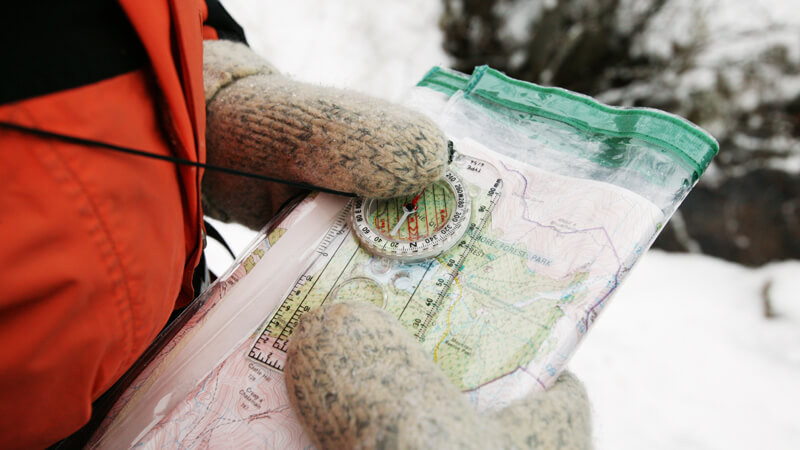
Photo by David Mansell
Travel backpacks and school bags have their place, but if you are intending to walk/hike for any length of time (i.e. over 3 hours) you probably want to consider investing in a bag which has a capacity of at least 30 litres and an adjustable strap system. It is extremely important for your comfort, that the bag is adjusted properly for you. If you don’t have a friend who is able to help when you go to choose a backpack; the staff in the shop are usually trained to help.
If you intend to climb, the length of the back system could be very important as the last thing you want while you’re climbing is for your backpack to be hitting the back of your helmet and impeding your vision. This is more likely to be an issue if you are less than 160cm tall.
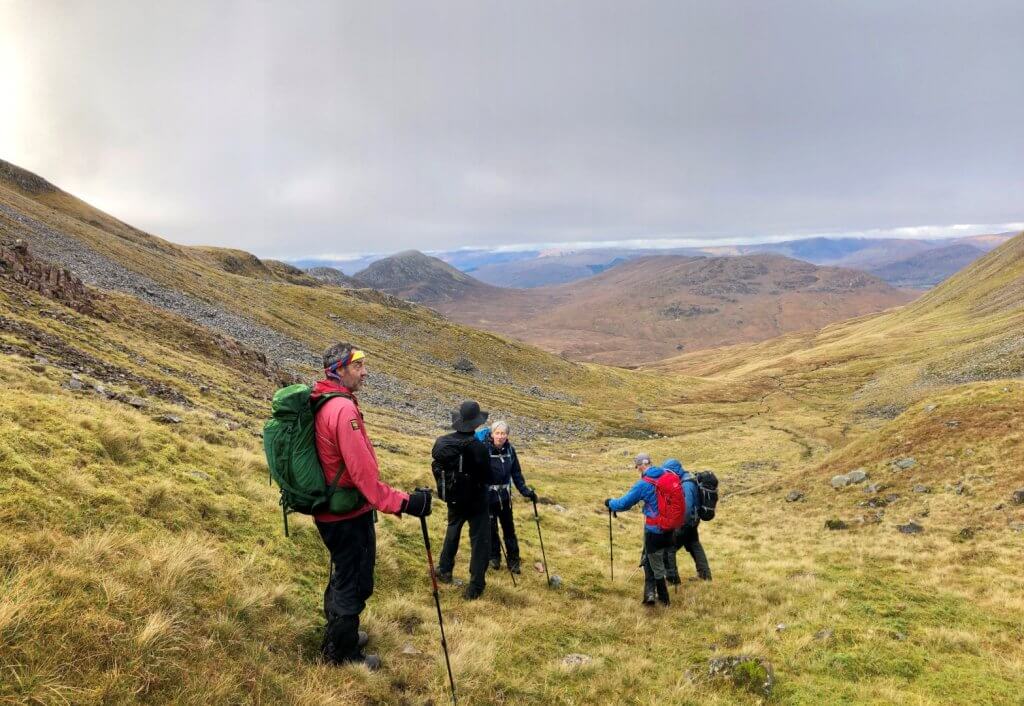
Strange as it may seem to some, sunscreen is important even in Scotland. Our days in summer can be very long which means that you could be out in the sun for more hours than you anticipate and there is often very little shade when you’re high in the hills.
The most commonly available midge repellent is Smidge but there are more and more products coming on to the market which are more enrionmentally friendly and good to your skin. Highland Soaps produce a skin cream scented with bog myrtle. Bog myrtle grows wild in the Highlands and naturally repels midges.
There’s also another natural brand called Beastie Be Gone which you might want to investigate.
Only really necessary as a camping addition. If you’re not planning to stop for long then a midge net will probably not be necessary. Also bear in mind that if you are in a windy situation then you won’t encounter any midges anyway as they can not cope with any more than a light breeze.
This might be something which lives in the bottom of your backpack and never gets used – but that’s a good thing. If you’re hiking with a guide, you probaby won’t need one either as the guide will carry one as a matter of course for the safety of the group.
A portable/emergency shelter is not necessarily just for emergencies but can provide you with a wind break when you need to take a break to eat or whatever.
Seriously? Yes, there are occasions when it isn’t windy and cold!
You’ll find that you’ll get conflicting advice on using poles, depending on who you speak to. My father is against them; I use mine all the time. They are very useful for river/stream crossings; to help with your balance.
If you check out the photo below though, the vote seems to be in favour of poles when hiking here in the Highlands.
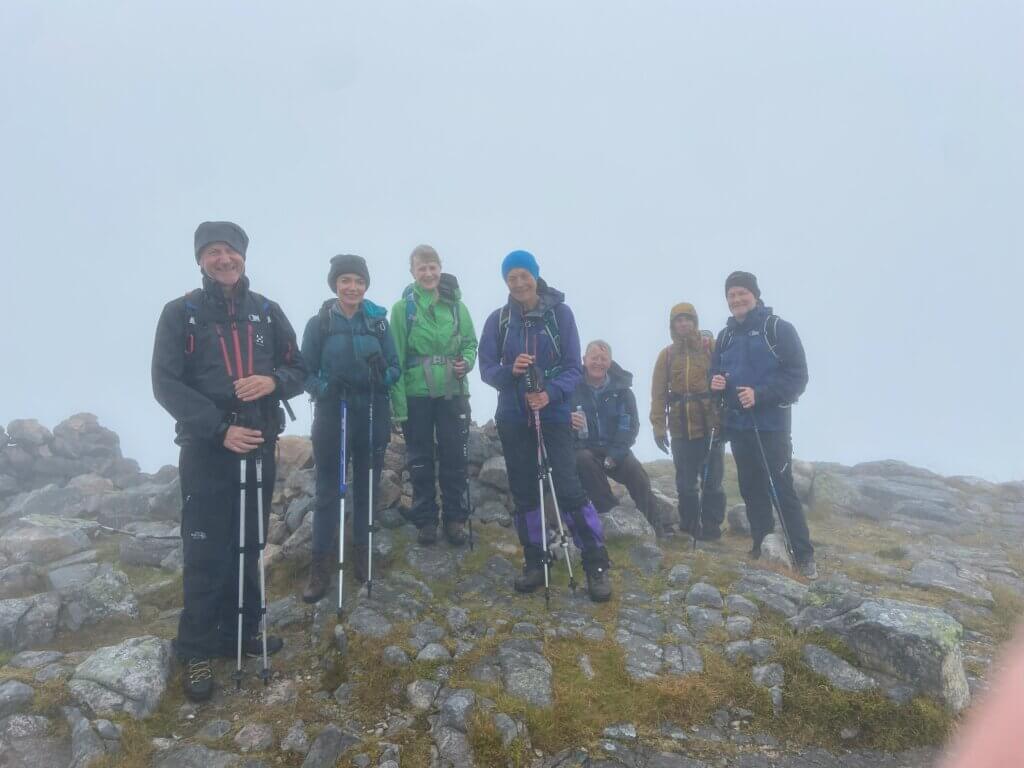
Possibly the most useful thing to have in your first aid kit. It’s probably worth adjusting your first aid kit if you’ve bought a premade kit. It’s unlikely that you’ll need a huge number of field dressings or slings, but more than likely that you’ll need a stock of compeed for blisters, tweezers (to deal with splinters) , possibly some rehydration tablets and paracetamol.
You can buy commercial versions but the most satisfying will probably be one that you make up yourself if you have time. We like a home made grain free granola mix. Recipe here.
There’s no chocolate in this particular version but there are plenty of options which contain chocolate: eg white chocolate, cranberry and pistachio.
You could also make a more savoury version or experiment with a high protein mix, depending on what suits your preferences.
Always a good option here in Scotland where you can easily have 4 seasons in one day. Also shorts are not always a good idea if you’re going to be brushing past any undergrowth as you’ll need to be aware of ticks.
Unfortunately even in what you might consider to be the height of summer (July and August) it can be extremely cold on the mountain tops and it’s not unknown for snow flakes to fall!
You might not need the thickest winter gloves in the middle of the summer season but the wind can pick up at any time and particularly if you’re using poles your hands can be exposed and cool off quite quickly.
Wool is worth investing in particularly if you’re going to be hiking for more than one day. It doesn’t smell as quickly as artificial fibres; it breathes and it will be warm even if damp.
If you’re hiking any time from April to August, the daylight hours will likely be long enough that you might think that you don’t need a torch, but it is a useful piece of kit to have in your bag in case you take a wrong turn or decide to be out longer than you originally planned.
Always a good idea to add a waterproof lining to your bag, even if you have a rucksack cover. Unfortunately rucksack covers can blow off your pack quite easily and then inevitably water will ingress.
This might seem like an obvious one, but you’d be amazed how many people show up without water bottles for one of our planned hikes. Some kind of reuseable water bottle is always best rather than bottled water from the shops.
A thermos can be used to keep drinks both hot and cold so don’t ignore the opportunity to carry a thermos in the summer.
We’ve covered quite a bit here and you can obviously take all under advisement as the heavier your bag the less likely you are to enjoy the day. It is a balance between weight and what you need to be comfortable throughout the day.
Enjoy!
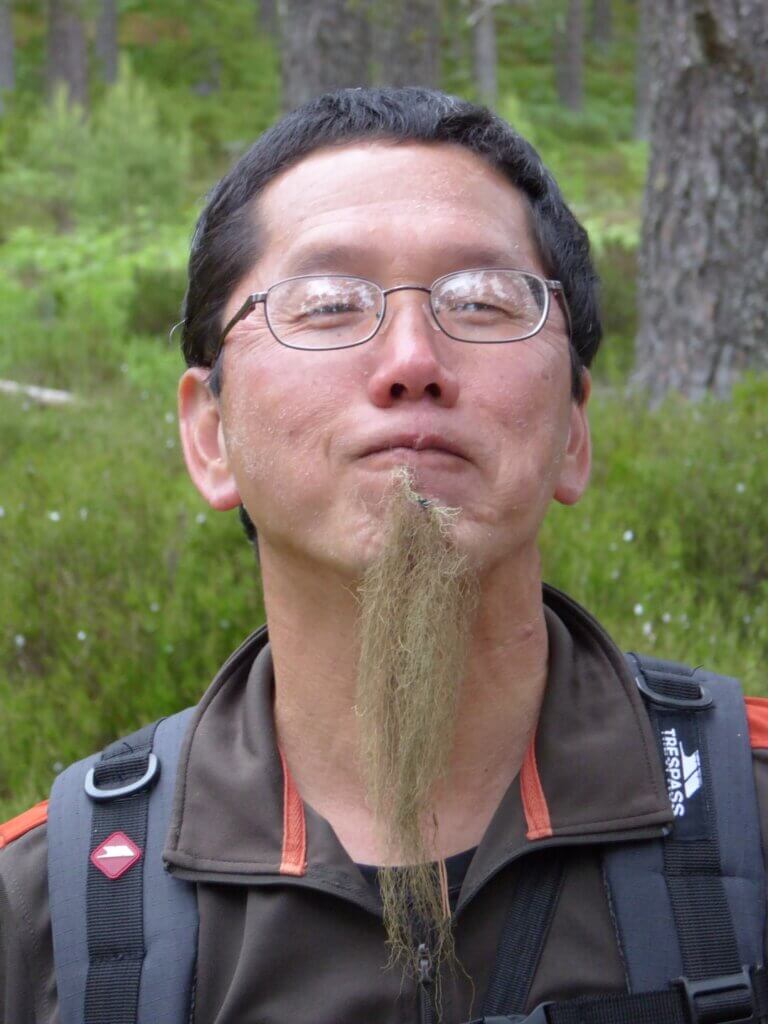
Playing with lichen
In the age of heightened environmental awareness, the principles of Leave No Trace are more crucial than ever, especially as wild camping experiences a surge in popularity. Despite the breathtaking beauty of Scotland’s landscapes, social media platforms are inundated with reports of litter and irresponsible waste management in some of the country’s most cherished spots. With the recent boom in camper van tourism, coupled with an increase in roadside camping, it’s evident that a minority of individuals are failing to uphold the principles of responsible outdoor stewardship.
e.g.
In the short term, finding solutions to these challenges may seem daunting. The fear of contracting illnesses, such as the coronavirus, has led many to prioritize personal safety over environmental responsibility. This has resulted in a concerning disregard for waste disposal, particularly human waste, in outdoor settings.
Potential solutions include:
It’s imperative to address the root causes behind these behaviors. Many individuals fail to grasp the connection between their actions and the degradation of natural landscapes. Some even harbor the misconception that litter left outdoors will miraculously disappear—an assumption that is disproven by the enduring impact of waste on Scotland’s delicate ecosystems.
At Scot Mountain Holidays we are steadfast advocates of Leave No Trace principles and adhere to the reduce-reuse-recycle ethos. Our commitment extends to our Wilderness Glamping Expeditions, where we prioritize environmental stewardship without compromising on comfort.
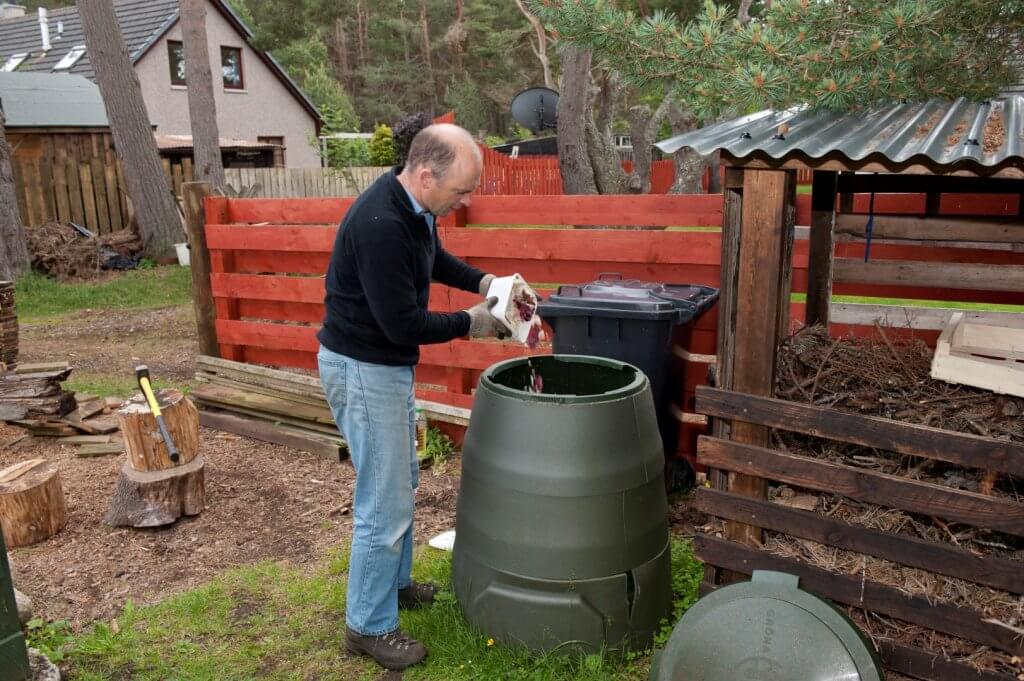
Andy using the hot composter at Fraoch Lodge. We can recycle all kinds of food waste, including cooked food scraps.
Please – if you’re going to camp by the roadside, by which we mean under 30 minutes walk from the road or within sight of cars/a road – pack a shovel and make sure you bury your waste. Once you’ve prepared your toilet site and done your business, you can use the lighter to burn the paper, then bury what’s left. Human waste will degrade far more quickly if it is buried.
It’s a shame that wild camping is getting such a bad name a the moment here in the Highlands. We like to distinguish between roadside camping, dirty camping and wild camping. Our new Wilderness Glamping Expedition is really “pure” wild camping following the Leave No Trace principles and the Scottish Outdoor Access Code completely without sacrificing comfort.
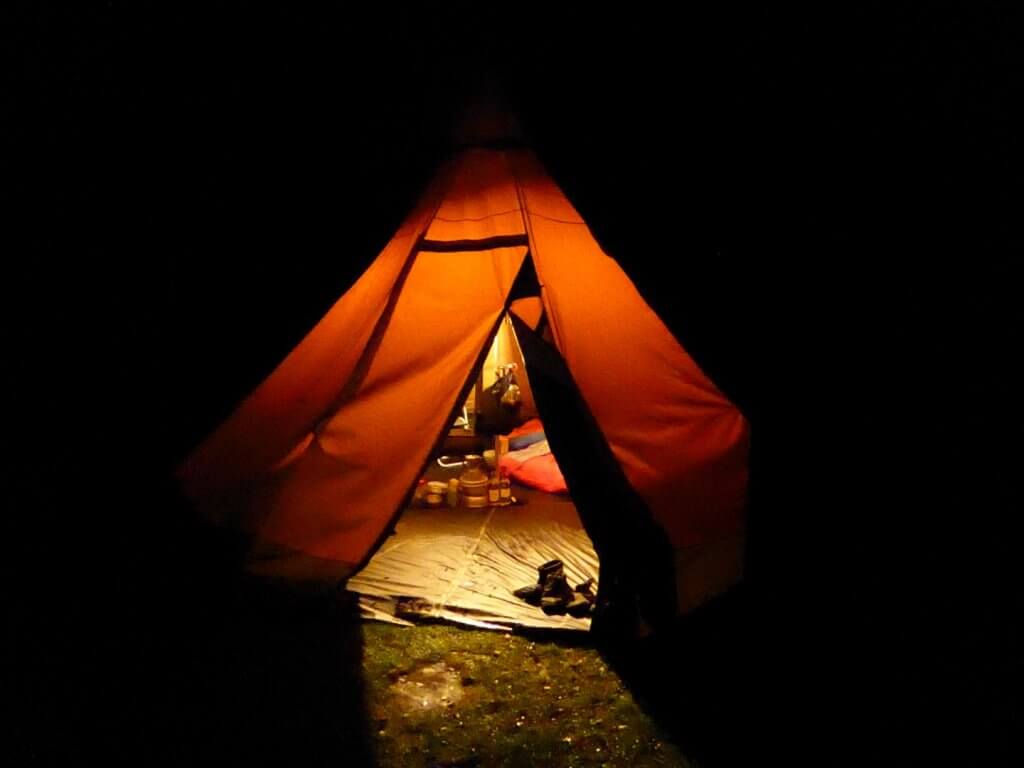
Our Tentipi on the wilderness expeditions
Is it the case long-term though that camping in whatever form it takes is really the problem? Perhaps we’re facing a more serious issue as per Chris Townsend’s article below.
Interesting perspective from Chris Townsend Gain insights from Chris Townsend’s perspective on the real threat to wild places: industrialization.
A beginner’s guide to guiding in Scotland Explore Fiona Russell’s beginner’s guide to guiding in Scotland for valuable tips and insights into responsible outdoor recreation.
Together, let’s embark on a journey towards sustainable wild camping, ensuring that future generations can continue to marvel at the untamed beauty of Scotland’s landscapes.
All content © Copyright Scot Mountain Holidays 2025
Responsive web design by Summit Web Solutions